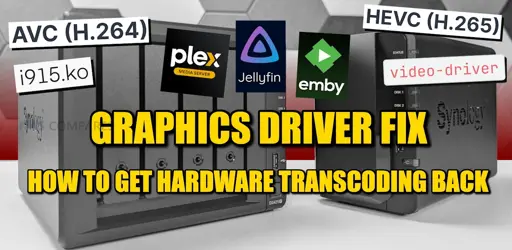Synology’s 2025 refresh brought the DS225+ and DS425+ with the familiar Intel Celeron J4125, but it also quietly removed the kernel graphics driver support that Plex, Jellyfin, and Emby use for hardware transcoding of H.264 and HEVC. This guide explains what changed, why it matters for real-world streaming, and how you can restore GPU-accelerated transcoding on these models using an unofficial SSH method shared by the community. If you rely on your NAS to reshape 4K or high bitrate files for phones, tablets, hotel TVs, or limited connections, this walkthrough will help you get that efficiency back.
This is some bullshit. I have an old DS418+ I’ve been thinking to upgrade from. But with this change I won’t be getting another Synology.
what reason do they give for removing the feature?
Synology confirmed the change in support tickets, explaining that both H.264 (AVC) and H.265 (HEVC) transcoding had been deliberately blocked at the kernel driver level. The company cited licensing costs for HEVC, even though AVC is license-free, and argued that most client devices already support native playback.
Yeah I think I just decided on TrueNAS as my next platform.
Man Synology is going to shit these days.
The next update I have pending for Synology Office needs me to agree to AI use on my server. No thanks.
Man, Synology has really gotten worse every year.
Are there any great alternatives that are easy to use off the shelf (with our own drives) that can compete here?
I’m basically to the point where my next NAS will end up just being a linux desktop running truenas which sounds like a lot of tinkering for something that should have a simple solution. I don’t want to have to buy some big expensive enterprise array for a prosumer use case.
TrueNAS. More control for slightly more work up front. Hardware will be easier to maintain. Lots of gamer desktops that won’t run Win11 available that probably have enough SATA ports to get the job done.
Gamer desktops tend to be power hogs. Running them 24/7 can rack up some hefty power bills, plus noise, plus space, plus other tradeoffs.
Better a used thin client.
A thin client for a NAS? That’s a hard no for me. Take the GPU out if you don’t need it, put a more efficient PSU and it will sip power as long as you aren’t running 27 virtual machines on it. I guess it’s more space than a thin client, but I have no idea how you are getting multiple HDDs or SSDs in a tc. USB is trash at long term data storage, and having a bunch of external drives and cables isn’t superior to a slightly bigger box. Not to mention anything that’s actually sold as a thin client probably won’t run ZFS very well if at all. If it’s not ZFS and it’s not hardware raid what the hell is the point of having network storage? Save the TC for a docker host or host a VM on your NAS that it can connect to instead.
Off the shelf nas? Build your own. I use Xpenology. It turns my hardware into a synology nas. I did buy a Unas case, so it is a nas style, but anything that holds disks will work. Yes a little tinkering still but not much. Bootable usb stick is easy enough. I’ve also used Freenas/truenas. I like them well enough, but I had gotten used to synology. Just don’t want to buy their hardware. I run two. Works just fine.
My next nas wont be synology, it will be qnap.
I’d recommend against it. It works “fine” but everything is in a thin, but walled, garden. Every app is some “Qsomebullshit.” They really, really want you in their ecosystem.
Id say the systems are underspec’ed as well. The model I bought years ago pitched itself as VM/container ready, but the chipset was so weak it couldn’t run anything worth a damn. It couldn’t even run a scrub on lowest priority without choking all other filesystem access. When a scrub takes 3 days or more, it wasn’t exactly a usable experience.
If you have the funds, i’d recommend 45drives. They make very good hardware and sell 4/8/15 disc form factors for homelabs.
Synology isn’t any different.
I’d argue a NAS is for storage mostly.
The vm/container side is less important than the “cant run a RAID parity check regularly because it makes the NAS useless” part. Thats my qnap experience. It might have gotten better, but it was shit heel for me, and the NAS was in the 1k range.
I’d argue that a NAS should be able to run containers at this point. NAS hardware does not need to be utterly gutless just because it can be. A versatile NAS is actually a great first choice for a homelab setup before you start to expand.
I got a Dell computer that was headed for the dump from someone, installed TrueNAS Scale on it, and it has actually replaced my Synology for everything other than straight up storage. Now the Synology does the storage, and everything else is in TrueNAS. It did take me a few lookups to understand the permissions on TrueNAS, as Synology is much easier to set up in that regard. I like the fine grain permissions controls, sure, but it was definitely not user friendly to a complete noob like Synology was.
Buy a QNAP, install an nvme drive and install your OS of choice (openmediavault for example).
Please dont… I got a qnap TS-H886 and it is the worst NAS I have used.
The so called ZFS that it is using is a very very old fork of openZFS that does not follow any standards. The inside is a complete mess.
The hardware has nothing to do with the ZFS version, like I said, if you are unhappy with it, change the OS (you can’t on most of the Synology hardware btw). Mine runs silent and got 0 issues with ZFS, it is a TS-464.
The hardware has nothing to do with the ZFS version,
Yeah but the QuTS OS of QNAP is in this case. It is not as straight forward to install a other OS on the thing. Specially a NAS OS like TrueNAS scale. having to enable dev mode on truenas and compile a custom driver for the fans to work is not as straight forward for most people. it is not just the ZFS implementation that’s bad also their whole OS it self is.
I literally don’t understand your issue with QNAP hardware, it sounds like your issue is TrueNAS, the only thing I did to change the OS from QuTS to OMV was install an NVME drive and select an USB drive with new OS at the boot menu. No drivers, no dev mode, no nothing.
The cheapest option at TrueNAS is +1100$, I’m not paying that when my minimum requirements were a low TDP CPU with HW encoding and a chasis with 4 disks.
I didn’t say the hardware was bad. The software is. But the issue with the hardware at least for some of those systems is the fan controller.
I’m with you here. I have put qnaps in dozens of smb client solutions and I have only ever had problems with one of them. I don’t stan qnap - truenas all the way. But their offerings are not nearly as bad as this thread seems to imply.
OMV took me some time to learn and setup, but I love the thing. I wish it had a file manager with root access thoigh. Learned to do without though, and with Docker really no need.
Stuff like that puts me off. By default it’s basically illegal, so we have no idea when the developers will need to retain legal counsel that explicitly tells them to delete everything and cease discussing it.
Support and maintenance are a nightmare, and based on the other folks here talking about it, it’s certainly something to have to tinker with heavily.
If i’m going to have to tinker, i’m going to go with FOSS stuff if I can. I’d rather learn something that will be useful for a while.
I use Xpenology on an HP Gen 8 microswrver, a pretty nifty piece of kit. Works great, but setting up and upgrading versions can be a rather involved process.
At this point, I’d say build your own if you are wanting anything more than basic file sharing.
Lots of resources out there and even NAS style cases to make it basically the same as any off the shelf NAS.
Xenology has been mentioned here, but I haven’t used it
FreeNAS is good, but I haven’t used it in years.
OpenMediaVault is supposed to be good, but again I haven’t used it.
Unraid is good and has super easy support for docker. I primarily use this because of its ability to use different disk sizes for the array and does what is the equivalent of software RAID. It’s not the fastest thing on the market, but for my use case (primarily Plex/Jellyfin) I don’t need the fastest reads or writes. It supports hardware passthrough for VMs or to docker containers so they can take advantage of hardware for acceleration. It also runs off a flash stick, so I don’t waste any disks on the OS.
I bailed on Synology a few years ago. I’ve been so much happier rolling my own NAS with Alpine Linux running on a Raspberry Pi 4.
Which case are you using for the hot swap trays?
What enclosure(s) did you use?
If you have a 3d printer, or access, o know someone willing to print for you, there are many free models out there
Definitely an option, but for the price of a Pi with all the extras, case, power supply, etc, you can get a used thin client that is way more capable.
There is a guy on YouTube that often reviews these things, and discovers some models that are surprisingly capable.
I’m looking for a NAS and Synology was on the top of my list. But their new models only support Synology HDDs. That is already a huge red flag. And now that. Feels like Synology really doesn’t care about their customers…
I might go with a self build solution.
Synology publishes a list of certified non-synology drives, and warns you that drives outside the list are not recommended, but, at least in non enterprise models, allows them to be used. I believe there is some rather easy way (some config file change or the like) to circumvent the limitation, but yeah, dick move.
Go with a self build + unraid. NGL a Ryzen 5500 build is so cheap and much more powerful than these overpriced boxes, and unraid is pretty good. If I didn’t buy a ds415+ a couple of years ago I’d swap over.
I am back on Kodi on Android TV box for a long time.
The official Synology app kind of sucks anyways. I used to use the Samsung app that played like 75 percent of the movies and not the rest, some codec BS.
So kodi is not push, it’s pull. That whole Mediaserver thing is obsolete with it. It’s a pity because technically that other system is superior and is running for no reason now.
Oh and my nas is so old it is too slow to transcode anyways.








